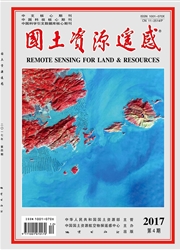

 中文摘要:
中文摘要:
传统的遥感地质填图方法较少考虑到一个像元中多种地物共生存在的情况,因此所填图件难以反映矿物的分布特征。针对线性混合模型解混精度不高的问题,使用二次散射非线性混合模型对高光谱数据进行光谱解混,并在此基础上,提出了k(k逸2)类地物的填图规则。采用美国内华达州Cuprite地区AVIRIS数据进行填图实验,将其结果与Clark等的填图结果进行对比。实验结果表明:与线性模型的矿物填图相比,基于二次散射非线性混合模型所填图件更加接近矿物的真实分布;使用k(k逸2)类矿物填图规则的填图结果细节丰富,与Clark等人的填图结果吻合度高。
 英文摘要:
英文摘要:
Traditional geological mapping methods usually cannot conduct mapping for the whole study area and takes little account to the situation that a variety of features has symbiotic combination in one pixel, which makes it difficult to reflect the complex geological distribution characteristics. Since the unmixing accuracy of the linear model cannot meet actual application need, the secondary scattering model was used to the unmixing of hyperspectral data. On such a basis, this paper proposed k (k ≥2) class mapping rules based on the unmixing result. The Nevada Cuprite AVIRIS data were used in the experiment, and actual mapping results obtained by Clark et al. were taken as the reference. The comparison results have shown that mapping results based on the secondary scattering mixture model are closer to actual ground feature distribution than those based on the linear model and, in comparison with the results from one class mapping rule, the results using k (k≥2) class mapping rules have richer details and are closer to the results obtained by Clark et al.
 同期刊论文项目
同期刊论文项目
 同项目期刊论文
同项目期刊论文
 Detection of Regions of Interest in a High Spatial Resolution Remote Sensing Image Based on an Adapt
Detection of Regions of Interest in a High Spatial Resolution Remote Sensing Image Based on an Adapt Remote Sensing Image Fusion Based on Integer Wavelet Transformation and Ordered Nonnegative Independ
Remote Sensing Image Fusion Based on Integer Wavelet Transformation and Ordered Nonnegative Independ 期刊信息
期刊信息
